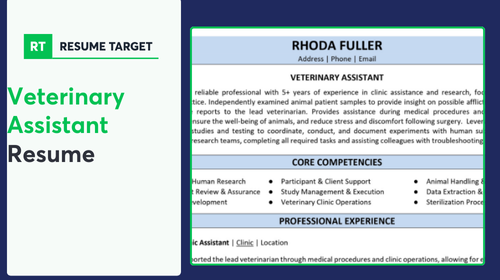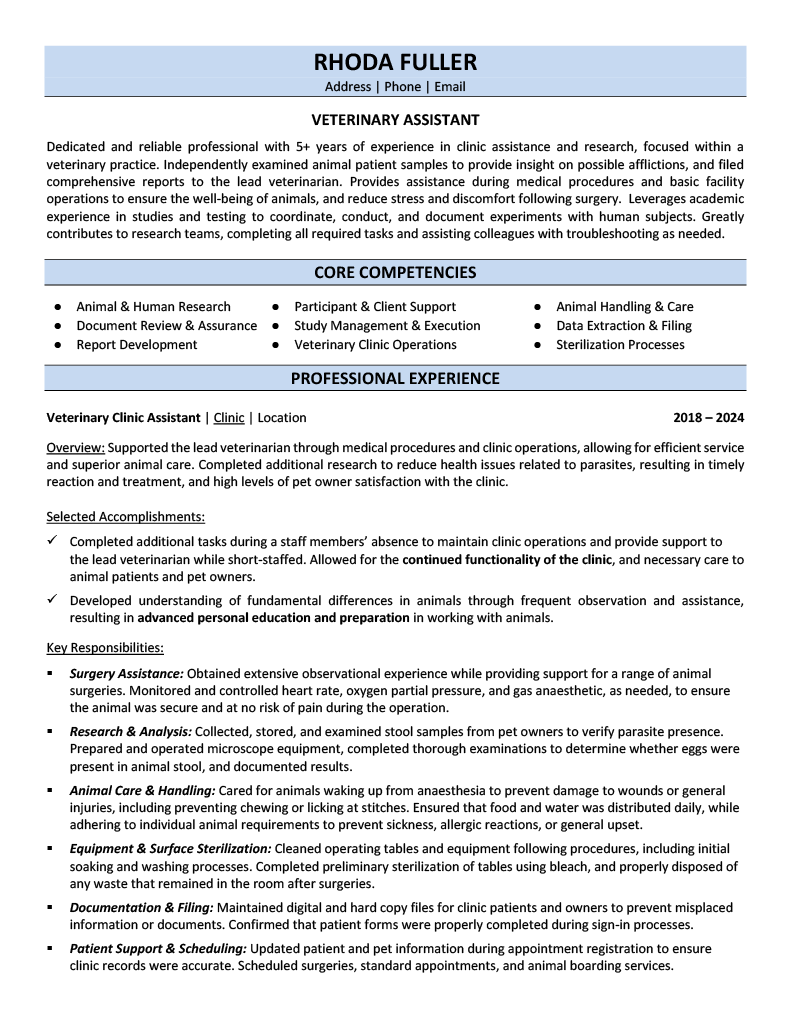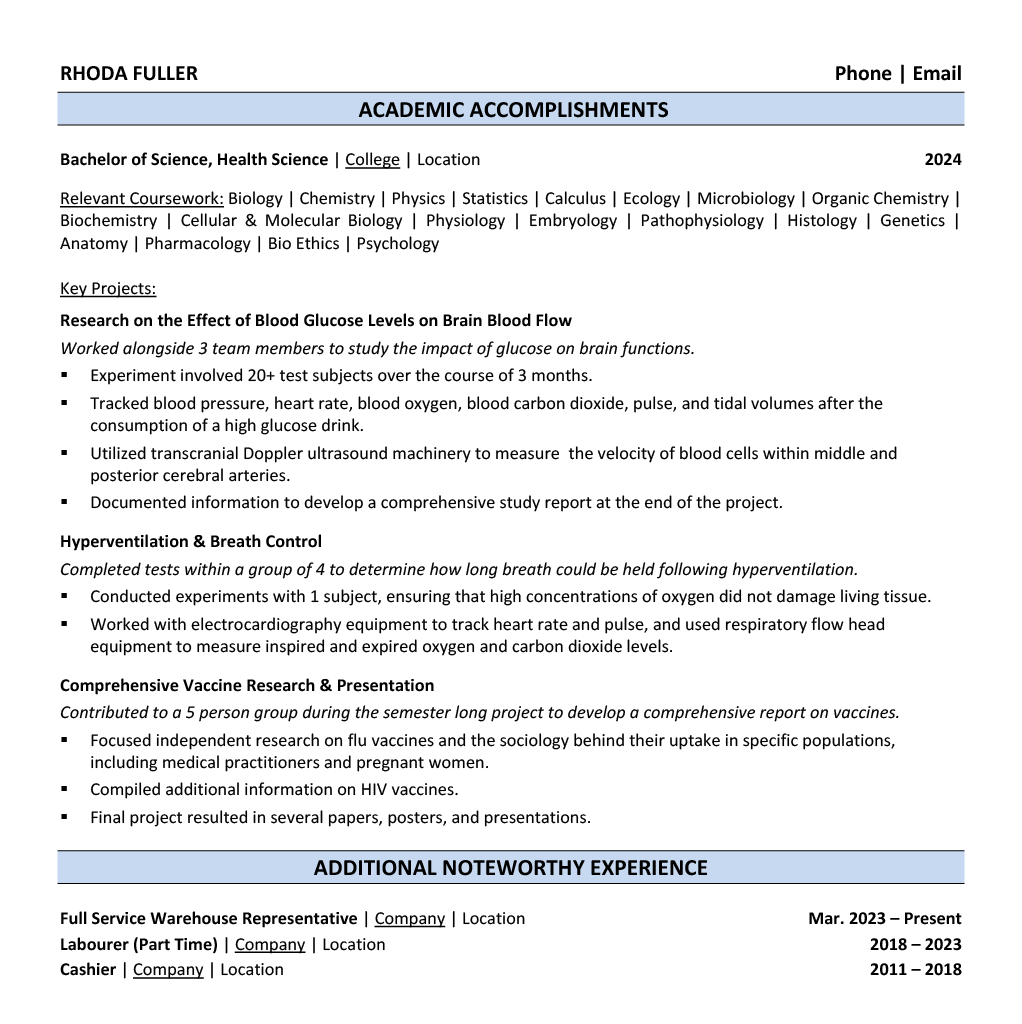

Caring for animals comes naturally, but describing your skills on paper feels like wrestling an uncooperative cat. Your daily work saves lives, yet your resume might not show your true capabilities.
Are you struggling to showcase both your technical skills and your compassionate nature in your resume? You need a document that captures your ability to handle both the medical aspects and the delicate client interactions that make you exceptional at your job.
Resume Target specializes in helping Veterinary Assistants translate their hands-on experience into powerful career documents. We'll help you create a resume that demonstrates your medical knowledge, animal handling expertise, and client communication skills to land more interviews.


As the ultimate advocates for animal health and welfare, veterinarians don't just treat pets – they serve as medical detectives, surgeons, and public health guardians who diagnose and treat medical conditions across species while protecting public health through disease prevention.
Your role as a veterinarian requires mastering multiple disciplines – from performing intricate surgeries and interpreting diagnostic tests to prescribing medications and counseling pet owners – all while adapting your approach for patients who can't verbally describe their symptoms.
Whether you're drawn to caring for beloved family pets, ensuring food safety through livestock care, or advancing veterinary medicine through research, the veterinary field offers diverse career paths that let you combine your passion for science with your commitment to animal welfare.
Let's talk about the exciting earning potential in veterinary medicine! As a Veterinarian, your passion for animal care can translate into a rewarding career with impressive compensation. Starting salaries begin in the lower range, but here's what's exciting - as you gain experience and potentially specialize, your earning potential can more than double. And guess what? Working in private practice typically offers the highest earning potential, while positions in education and government provide stable, competitive wages with excellent benefits.
Figures from: U.S. Bureau of Labor Statistics
Starting as a veterinarian requires a DVM degree, but your career can soar from there. From private practice to specialized roles, you'll find numerous paths to advance while helping animals thrive.
Beyond basic animal care, advancing in veterinary medicine requires a combination of clinical expertise and leadership capabilities.
- Advanced surgical techniques - Veterinary diagnostic technology - Practice management - Client relationship managementStarting your veterinary career journey can begin with entry-level positions like veterinary assistant or kennel technician, giving you valuable hands-on experience while working toward your DVM degree.
To build a strong foundation for your veterinary career, you'll need to develop essential skills including strong interpersonal communication abilities for client interactions, alongside technical expertise and problem-solving capabilities.
Requirements from Pick The Brain
From California's bustling pet care scene to Florida's growing animal health sector, vet jobs are thriving nationwide.
Figures from U.S. Bureau of Labor Statistics
Struggling to showcase your animal care experience, medical knowledge, and client service skills all in one resume that catches a veterinary clinic's attention? This comprehensive, section-by-section guide will walk you through creating a professional veterinary assistant resume that highlights your hands-on experience and passion for animal care.
If you're like most veterinary assistants, crafting the perfect resume summary feels as challenging as calming an anxious pet during their first clinic visit.
While you excel at monitoring vital signs, assisting with procedures, and providing compassionate animal care, translating these hands-on skills into compelling written statements can leave even the most experienced vet assistant feeling uncertain about how to best showcase their capabilities to hiring managers.
How would you describe your overall approach to animal care and your ability to balance both technical medical support and compassionate patient handling?
Reason: This question helps frame your professional identity and core value proposition, showing potential employers how you blend essential technical skills with the crucial emotional intelligence needed in veterinary care.
What would you say are the primary environments and types of veterinary practices where you've developed your expertise, and how has this shaped your professional capabilities?
Reason: This helps establish your professional context and versatility, allowing employers to quickly understand your experience scope and how it aligns with their practice needs.
How would you characterize your ability to support both veterinary professionals and pet owners while maintaining efficient clinical operations?
Reason: This question helps articulate your role as a crucial bridge between clinical staff and clients, highlighting your ability to maintain practice efficiency while delivering quality care support.
As a veterinary assistant, you'll need to showcase both your clinical capabilities and your ability to handle the daily operations of an animal care facility.
Your resume should highlight technical skills like monitoring vital signs and assisting with procedures, alongside essential soft skills such as pet handling, client communication, and the ability to remain calm in emergency situations.
Showcase your animal care expertise by organizing your experience into three powerful sections: a concise role overview highlighting your clinical setting, measurable achievements demonstrating patient care success, and core responsibilities that spotlight your hands-on veterinary skills.
Many Veterinary Assistants struggle to effectively showcase their diverse mix of technical skills, animal handling expertise, and client service abilities in their achievements. Transform your experience into compelling metrics by connecting your daily responsibilities to improved patient outcomes, increased clinic efficiency, and enhanced client satisfaction rates.
A strong responsibilities section demonstrates how Veterinary Assistants contribute to animal health beyond basic caregiving tasks. Your role supports both veterinarians and pet owners, so describe your duties in clear terms that show how your work impacts overall clinic operations and patient care.
Your education and certifications demonstrate your commitment to animal healthcare and technical expertise in veterinary medicine. List your most recent and relevant credentials first, especially focusing on your Approved Veterinary Assistant (AVA) certification and any specialized training in veterinary procedures or animal handling.
Now that you've created a strong foundation using Resume Target's comprehensive resume writing guidelines, you're ready to transform your resume into a powerful tool for veterinary technician positions.
While many vet tech candidates focus solely on customizing their cover letters, tailoring your actual resume for each clinic or hospital's specific needs is what truly sets successful applicants apart.
A customized veterinary technician resume not only helps you bypass automated ATS filters by incorporating role-specific keywords, but it also demonstrates to hiring managers that you understand their unique practice requirements and animal care priorities.
Ready to make your vet tech resume work harder for you? Let's turn your experience into exactly what each employer is looking for - because when it comes to landing your dream position, a tailored resume is your most powerful ally!
Don't let a lack of professional experience hold you back from pursuing your dream career as a Veterinary Technician!
Your passion for animal care combined with your education, hands-on training, and volunteer experience can create a compelling resume that showcases your potential.
Focus on highlighting your clinical skills, animal handling experience, and relevant coursework to stand out to potential employers.
For more guidance on crafting the perfect entry-level resume, check out the Student Resume Writing Guide to ensure you're presenting your qualifications in the best possible light.
Your resume summary is your chance to showcase your passion for animal care alongside your hands-on experience from clinical rotations and volunteer work at shelters.
Focus on highlighting your technical skills, certifications, and any specialized training you've received during your education to demonstrate your readiness for this rewarding career.
"Compassionate and detail-oriented Veterinary Technician graduate with hands-on experience through 500+ clinical hours and volunteer work at local animal shelters. Proficient in laboratory procedures, animal restraint techniques, and monitoring vital signs, with additional experience in client communication and medical record management. Demonstrated ability to remain calm under pressure while assisting in emergency procedures and routine examinations. Seeking to leverage strong technical skills and genuine passion for animal welfare to provide exceptional veterinary nursing care at a progressive small animal practice."
Now's your chance to showcase the specialized training and hands-on clinical experience that makes you a qualified veterinary professional!
Don't just list your degree - highlight relevant coursework like animal anatomy, pharmacology, and surgical nursing, plus include standout projects like your externship experience or laboratory competencies that demonstrate your technical expertise.
unavailableRelevant Coursework: Animal Anatomy & Physiology | Clinical Laboratory Procedures | Veterinary Pharmacology | Small Animal Medicine | Emergency & Critical Care | Veterinary Surgical Nursing
Key Projects:
Surgical Assistance Protocol Development: Designed and implemented a comprehensive checklist system for pre and post-operative care procedures, resulting in improved patient monitoring efficiency and recovery outcomes.
Animal Wellness Clinic Initiative: Coordinated with a team of four students to organize and execute a community pet wellness clinic, providing basic care services to over 50 animals.
Transform your educational background, clinical rotations, and hands-on training experiences into a compelling skills section that showcases your readiness to provide exceptional animal care and support veterinary procedures.
As an entry-level Veterinary Technician, your combination of technical skills and compassionate care for animals positions you perfectly for a rewarding career in veterinary medicine, with numerous opportunities for growth and specialization.
When you spend your days focused on caring for animals and supporting veterinarians, it can feel impossible to translate all those compassionate moments and technical skills into compelling resume content that truly shows your impact.
At Resume Target, we understand the unique challenges veterinary technicians face in the medical field, and we've helped hundreds of vet techs showcase their diverse skills - from surgical assistance to client education - in ways that catch hiring managers' attention.
Our deep knowledge of the veterinary industry means we know exactly how to highlight your specialized certifications, technical procedures, and patient care expertise to help you stand out.
With the veterinary field growing rapidly and clinics actively seeking skilled technicians, now is the perfect time to transform your resume into a powerful career tool - contact us today to get started.
Impress any hiring manager with our Medical resume writing service. We work with all career levels and types of Medical professionals.
Learn More → Medical Resume Writing Services